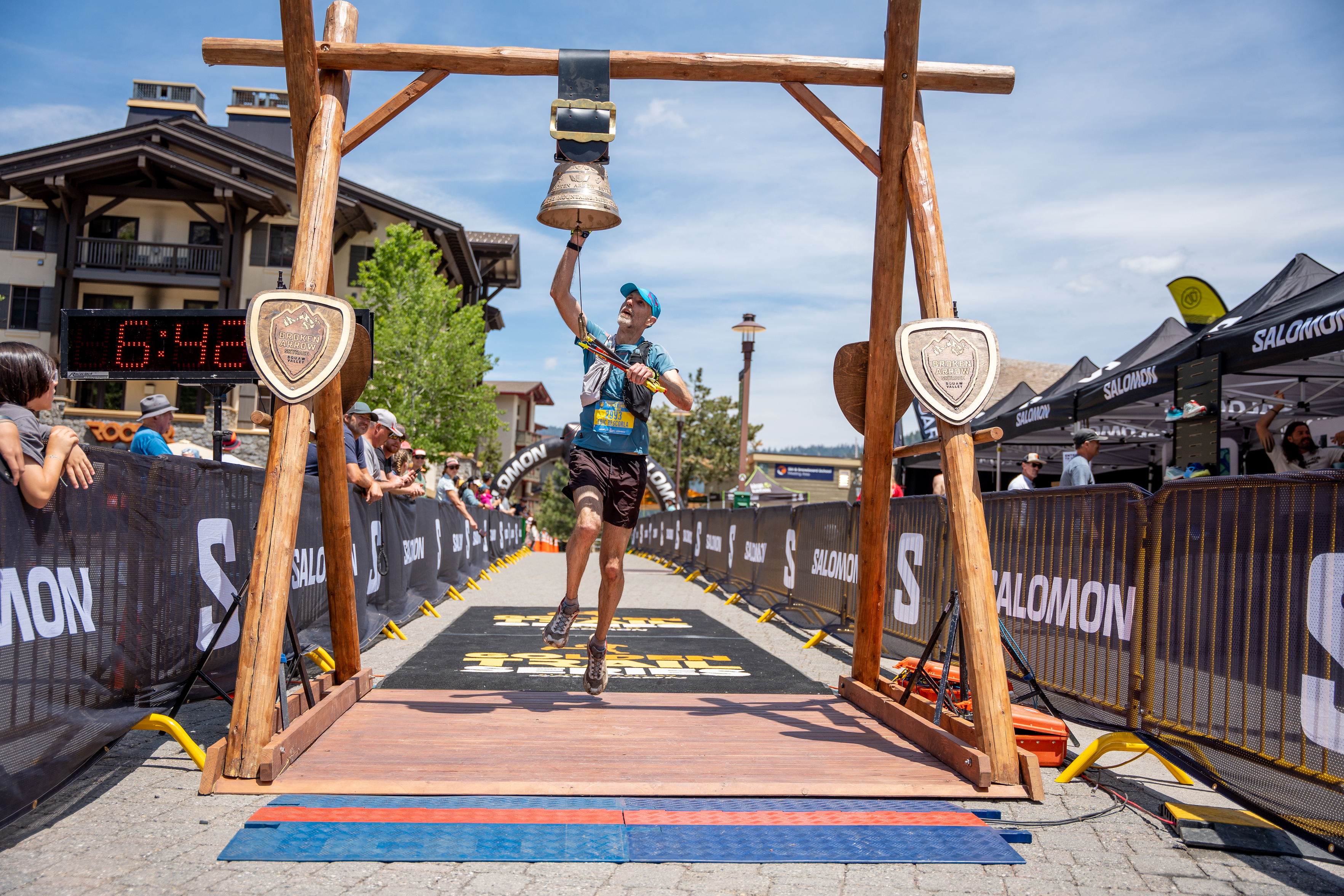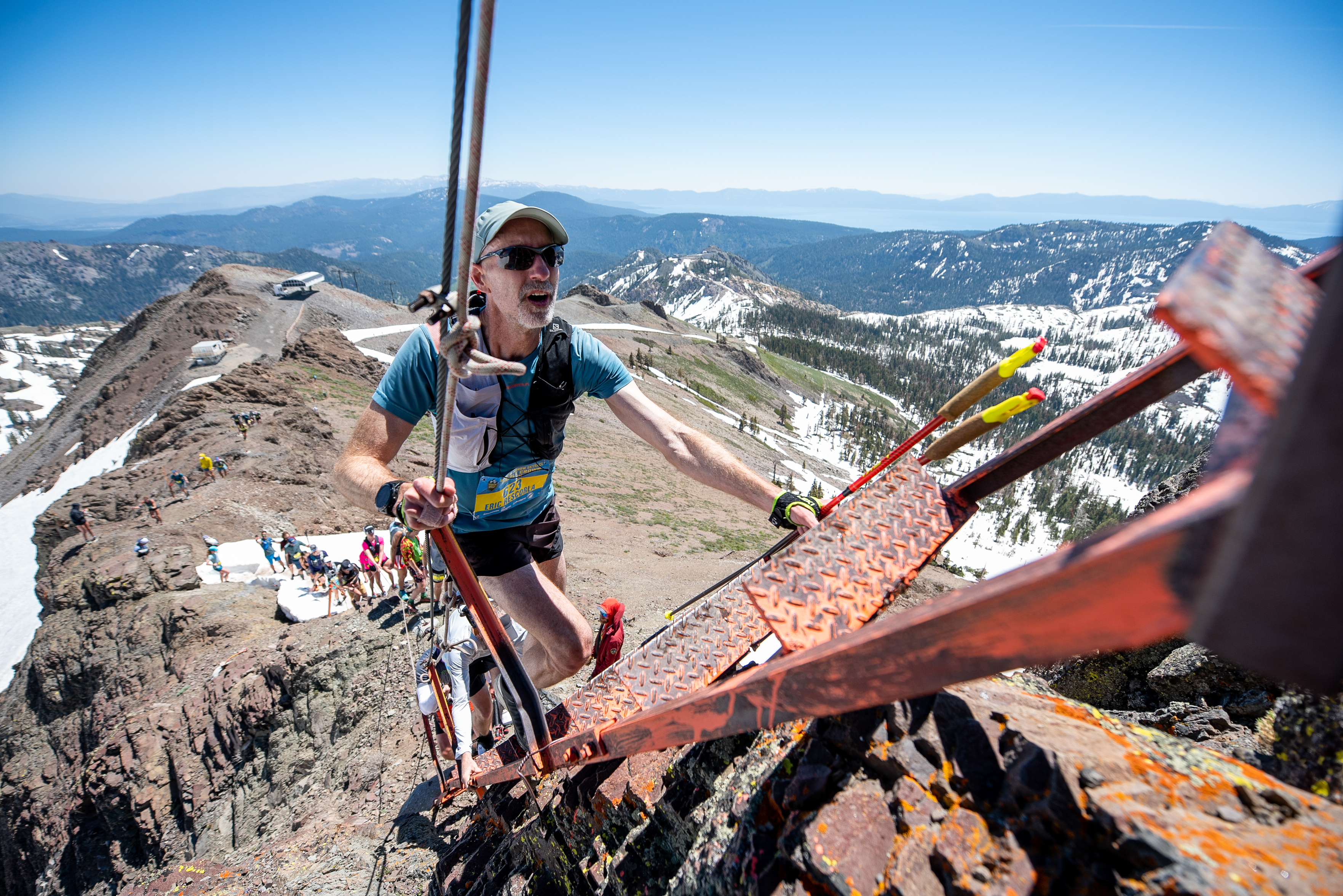Broken Arrow Triple Crown Race Report
Posted by ekr on 10 Jul 2023
This year has turned out to be light on racing in part because I was kind of wiped out after last year and in part because I had signed up for the Broken Arrow Skyrace in Tahoe in June. Broken Arrow isn't actually one race but a race festival that takes place over three days. All of the races are relatively short compared to what I usually do (the longest is nominally 46 km/29 mi, but they offer what's called the "Triple Crown" which consists of the following three races over three days, listed as:
| Race | Distance | Vert |
|---|---|---|
| Vertical Kilometer (VK) | 4.8 km/3 mi | 914 m/3000 ft |
| 46K | 42.5 km/26.5 mi | 2774 m/9100 ft |
| 23K | 21.75 km/13.5 mi | 1443 m/4700 ft |
The 46K is supposed to be two loops of the 23K, but you'll notice that the distance and vert don't quite line up and of course the distances don't actually match the names. This is in part because of rerouting due to the huge amount of snow that dropped in the Sierra this summer (also preventing me from doing the warmup adventure run in the Sierras that I had planned). In the event, the 23K got totally rerouted on race day anyway.
Anyway, naturally I decided to do the Triple Crown, both because it sounded fun and because I wasn't really willing to drive to Tahoe for a 46K. Also, they gave out a massive amount of swag. My overall plan was to push the VK moderately hard, race the 46K, and then see what I could do on the 23K.
Flagstaff #
The race start is at Palisades Tahoe (6253 ft) and goes up from there, so you're at significant altitude the whole time. I've gone directly from sea level to altitude and raced before, with mixed results (OK at Tahoe 100K, awful at Tushars 70K) but often people actually feel worse on the second or third day at altitude (see Corinne Malcolm's excellent article on altitude adaptation at iRunFar.com), and so I didn't want to try to race three days in a row without any adaptation, so I decided to spend two weeks in Flagstaff (altitude ~7000 ft) beforehand.
On balance, I think this was a good choice. As usual, I felt lousy the first few days at altitude but by the time I had been there a couple of weeks I was feeling mostly adapted. I flew back on Wednesday and on Tuesday, my friend Kate, my son (3200m PR: 10:52), and I went to the Grand Canyon to do the Bright Angel–Tonto–South Kaibab loop. This was a bit of a hot dry slog on the way up, but I generally felt OK, so I figured I was ready for Broken Arrow, which of course is actually cold and snowy rather than hot and dry.
VK (results, finish video) #
Kate and I drove out to Tahoe Thursday morning where we were staying with Lisa and Stephen who were both doing the 46K. Kate was doing the VK and the 23K, so I was the only one doing the Triple Crown. We got there around 6 PM, but fortunately the race didn't start until 10 AM, so we were able to go out and grab some pasta and still get enough sleep.

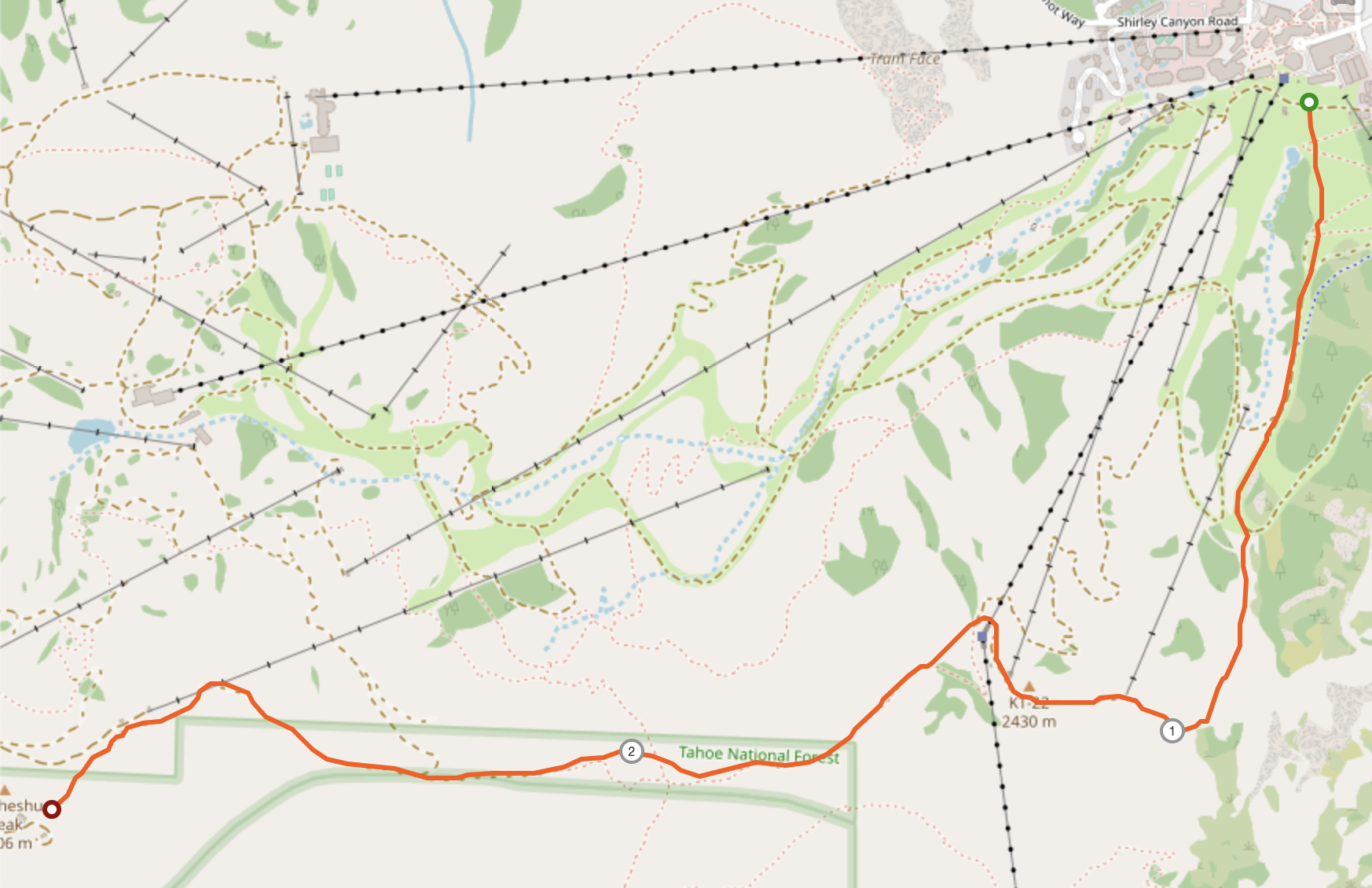
The profile for the VK is shown above. Looks gentle, but that's just a trick of perspective because it's stretched out; it's actually about 1000 feet per mile.
I'd never done a VK before, so I wasn't sure what to expect. The pros do it in about 30 minutes (winning time was 39) so I was expecting an hour or so, which means you're going at a fairly high intensity right from the start. On the other hand I knew I had to save for the 46K the next day, so it's a bit of a balancing act.
The initial climb was quite steep but on trail with good footing so I was moving pretty fast. I decided to start about midway through the field, which in retrospect was a bit of a mistake, as I immediately had to make my way through people moving slower than me. I was of course hiking at this point, but so was basically everyone else. Quickly, though, the climb turned into a snow slope, where things were quite a bit more challenging. At this point in the day, the snow was already quite slippery and even with poles(LEKI Fx.One Superlight[1]), I slipped a fair bit. The trick seems to be to step where others have stepped, where the snow is packed and you have a little more traction. It's very hard to pass people on this section because there are only a few lines up the slope and if you get outside the packed down areas you're slipping a lot. There were a couple places where super helpful volunteers had carved out snow steps and those were a lot easier.
Once you get over the first climb, there's a downhill of about half a mile, starting with snow and then moving onto rocky trail. This was the first part of the race where you had to run downhill on snow. I was a bit unstable and managed to trip and fall on the transition to dirt, jamming my 2nd and 3rd fingers on the left hand (but fortunately not breaking either of them like I did to my right 3rd finger in the Grand Canyon at the beginning of May).
From there on it's another climb mostly on trail until you drop off on a sort of fire road. I passed quite a few people on this stretch as the footing was good and so it's just a matter of your ability to power up the climb, something I'm good at. After the fire road, there's maybe 400 m of a fairly rocky (as in almost scrambling) traverse, at which point you get the the "stairway to heaven", which is this sketchy looking metal ladder that you really do not want to fall off of:
There was actually a bit of a backup at the ladder and I had to wait for some others to get over it. In retrospect I should have stowed my poles at this point because they get in the way of climbing and the finish is right after the ladder.
The ladder is obviously single file, and so at this point I figured the finish order was fixed, but there are actually some snow steps and a short flattish stretch of snow before the finish and someone passed me right after the steps before I realized I should sprint, which I tried to do, which resulted in slipping and falling again, but I eventually made it to the line.
Unlike other races, however, the VK just finishes at the top of the hill so there's not much of a finish line, just the arch and a few race staff standing around to give you your medal. Even the finish line drop bags are about a half mile away. I opted to wait around for Kate to finish, but I hadn't brought a jacket and it was super windy, so when she got to the top I was getting cold. We then headed down to the drop bags at the "Siberia" aid station to get our drop bags with jackets. From there it's about a mile to the top of the gondola for the ride down.[2]
That afternoon, Tailwind Nutrition was having a "meet and great" with ultra great Courtney Dauwalter to introduce their new Courtney-inspired flavor Dauwaltermelon. Back when I did Tahoe 100K in 2018, while my family was waiting for me at the finish line, Courtney rolled through en route to her second place overall at Tahoe 200, and spent a few minutes talking to my then 11 year old son, which he found really inspiring, so I got a chance to thank her for that. Courtney went on to absolutely shatter the women's Western States Endurance Run record the next weekend.
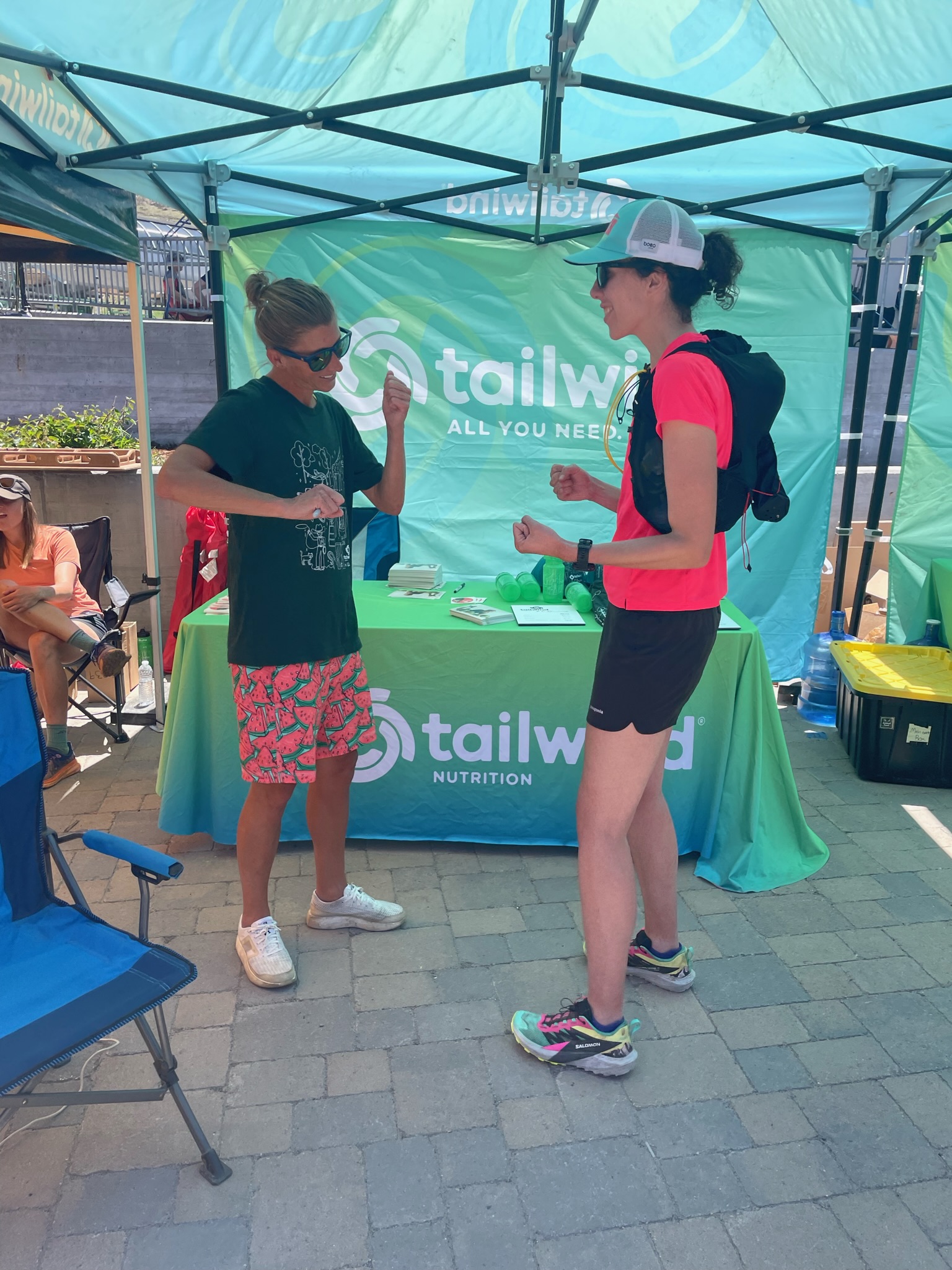
Kate and Courtney talking about ultra
I had brought a pair of the Kahtoola NANOspikes for the snow but didn't use them, in part because it never got super bad and in part because I didn't want to take the time to put them on. However, the trip down to the gondola was mostly snow so I did try them out and they seemed to help a bit, though they're Kahtoola's lightest and shortest spikes and the snow was about 6 inches deep, so they're not magic.
Overall: 1:07:02, 142/395 finishers, 7/39 M50-59
46K (results) #
The 46K was on day two and my plan was to push the pace a bit and then try to hang on for day 3.

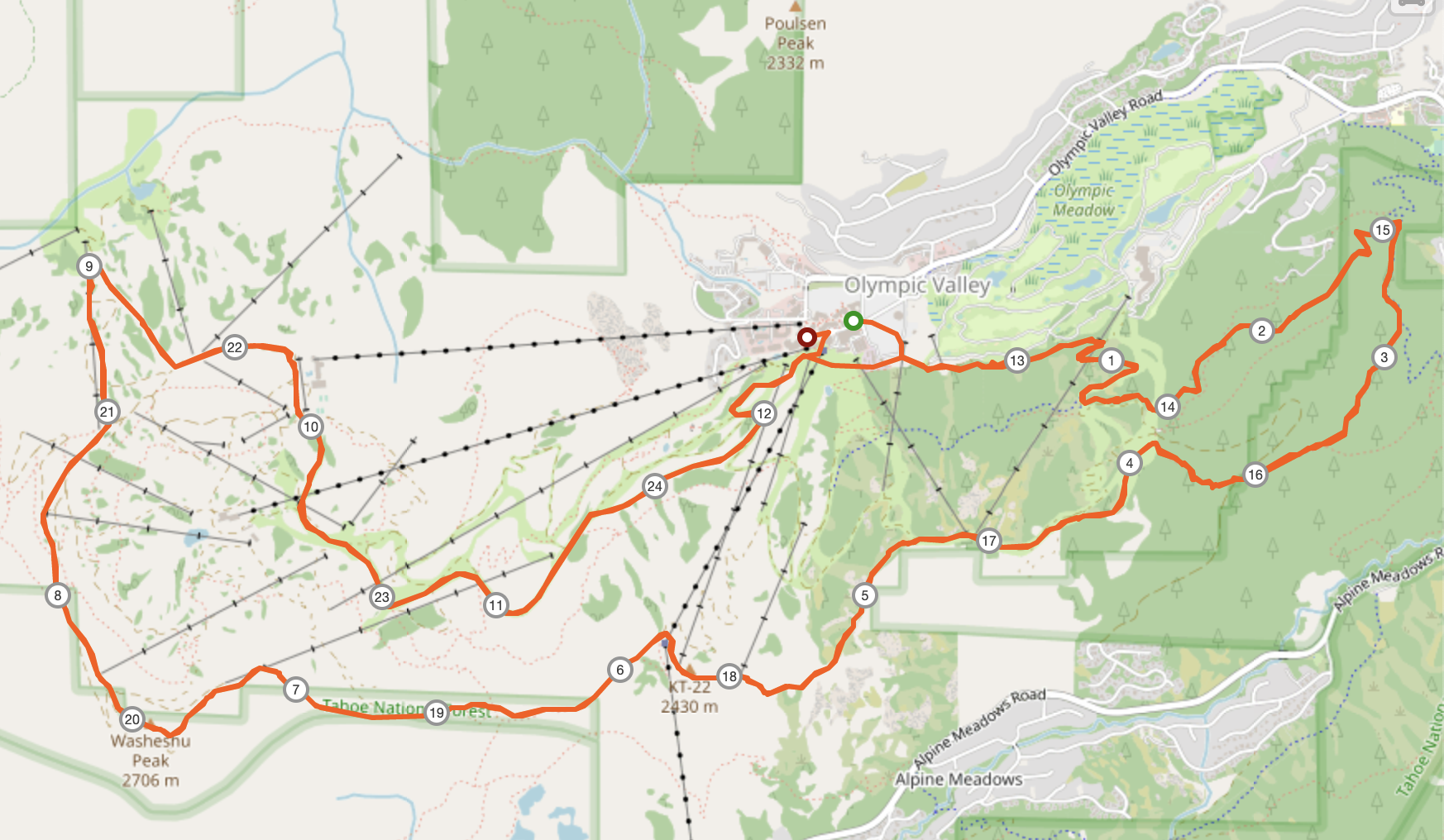
As I said earlier, this is two loops, arranged as follows:
-
A runnable rolling but gradually uphill section, partly on the Western States Trail.
-
A series of steep climbs on dirt and snow up to the Snow King aid station.
-
A semi-rocky traverse followed by a climb up to KT-22 where it rejoins the VK course.
-
From the top of the VK course there's a gradual descent on snow followed by a series of very steep descents.
-
A climb of about a quarter mile and 400 feet, again on snow.
-
A fast descent of about 1.5 miles on snow, followed by a mile on dirt road back more or less to the start.
And then you do it all over again. Simple. I didn't really know what to expect on this timewise, but I was thinking something like 7 hours.
After the VK, I was kind of worried about traction, so on Friday afternoon I dropped by Alpenglow Sports and bought a pair of the slightly more aggressive Kahtoola EXOspikes.[3] They're not that heavy and I figured I could carry them in my pack. Lisa was also doing the 46K and broke the rule about not buying new stuff for a race to get a pair of purple Hoka Torrents.
Lap 1 #
After having to fight my way through people on the VK, I decided to start out more towards the front. This turns out to have been a good plan because you first run across a parking lot and then there is a short section of fire road for a total of maybe 400 m and then you're into single track, so there was kind of a rush for position. I hadn't really warmed up—I usually don't before ultras as you can just warm up in the first few miles—and so I probably wasn't as fast as I should have been and things got bunched up in the single track. It didn't help that there was a low of snow runoff so you were literally running through a stream a lot of the way (no chance of keeping your feet dry!). Eventually I settled into my position, as usual being passed some on the downhills and passing people on the climbs.
After about 3.5 miles, you hit the first climb, which is a steep dirt section, so it was time to pull out the poles. The "trail" part of this climb was pretty rough anyway, so it didn't make much difference if you took a slightly different line and I pulled to the left of the line of climbers and passed a number of people en route to the top. After this, it's another climb mostly on snow up to the Snow King aid station, where I made my first mistake of the day.
As I mentioned, I had broken my finger in the Grand Canyon about 6 weeks before and while I was finally out of a splint, I was still supposed to "buddy tape" the broken finger to the next finger. Anyway, I'd started out wearing gloves but it was starting to get hot and so I wanted to take them off, but then I had to retape the finger and the coban I had been using didn't want to re-stick once it got wet, so I had to get one of the medics to do it with some medical tape. All of this must have taken like 3-5 minutes and I know a lot of people passed me. As they say, when you're stopped you're going infinity minutes per mile.
From Snow King it's a short downhill followed by a bunch of up and down (but mostly up), including a knife edge traverse over a bunch of scree. I took this really tentatively and a bunch of people passed me, but after the Canyon I was mostly focused on making sure I didn't fall and hurt anything, so I was willing to live with it. The climb up to KT-22 is steep and rocky, so I started passing people again.
From here it's the VK course and once I hit the snow traverse I decided it was time for the spikes. They're easy to get on, so it probably only took a minute or two. I do think this helped some as I felt like I was passing some people who were slipping, but it wasn't dramatic the way (I imagine) it would be with crampons. Everything was smooth to the top of the VK and I felt a bit more comfortable on the ladder this time, though I wasn't looking forward to having to do it two more times (the next loop and then the 23K).
The descent from the top of Washeshu Peak starts out straightforward: it's rock and then snow, but then right when I was expecting a nice flattish descent down to the gondola (and then what? not sure) there was a marshal telling me to take a left turn onto, well, I guess you'd call it a slope, but it was straight down and I remember saying something to the effect of "holy shit". The whole slope is something like -15%, and was about mid-calf deep in snow, so I spent the first part of it just desperately trying not to fall until I saw some of the chutes where people had been glissading. I took the hint and sat down and sledded down them (cold!). This got me to the bottom pretty fast and then I turned and saw something else I wasn't expecting: a 400 foot climb. I trudged up the climb, which actually wasn't so bad and then it's a short downhill to the aid station. I stopped and took off my spikes, as they didn't seem to help much on the snowy downhill, and I never used them again. This whole section was also deepish snow for another 1.5 miles or so and then it was onto fire road back to the start.
Split: 3:11:09
Lap 2 #
I wasn't feeling real good about having to do all this again, but I blew through the half-way aid station (split 1: 3:11:24) and headed back out for loop 2. There was definitely more power hiking on the Western States Trail this time, but I still managed to run a fair bit of it. By the time I got to Snow King again I was quite tired and was glad to see that they had Coke (caffeine + sugar = performance) which I used to fill up one of my bottles.
Once I got past Snow King, this loop seemed a lot easier, probably due to some combo of the caffeine and knowing that I was over halfway done. Also, as mentioned above, I'm a lot better on the steep climbs than I am on descents, so once we got past the opening rollers, I knew I just needed to push through those sections fairly hard and then survive the downhill. I did spend some time talking to one of the other runners who was doing her first trail race but had been a collegiate 10K runner and had done a lot of mountaineering and she gave me some tips on how to descend in the snow (heels first!), which seemed to help some.
Things were pretty uneventful from here: I made it to the top and felt a lot more comfortable on the glissading portions and on final the snowy downhill. I didn't need the poles on the downhill but at this point my coordination was starting to go and I couldn't quite get them into the quiver (the typical thing is that one end doesn't quite make it in), so I ended up just folding them and carrying them. By the time I hit the fire road I was mostly alone so I settled in at a comfortable but not all out pace, remembering that I had to race again on Sunday. Coming through the final stretch to the finish I just focused on trying to finish strong.
Split: 3:31:26
I had a bit of time before Lisa and Stephen finished, so I decided to go back to the VRBO and shower and change, but still made it back in time.
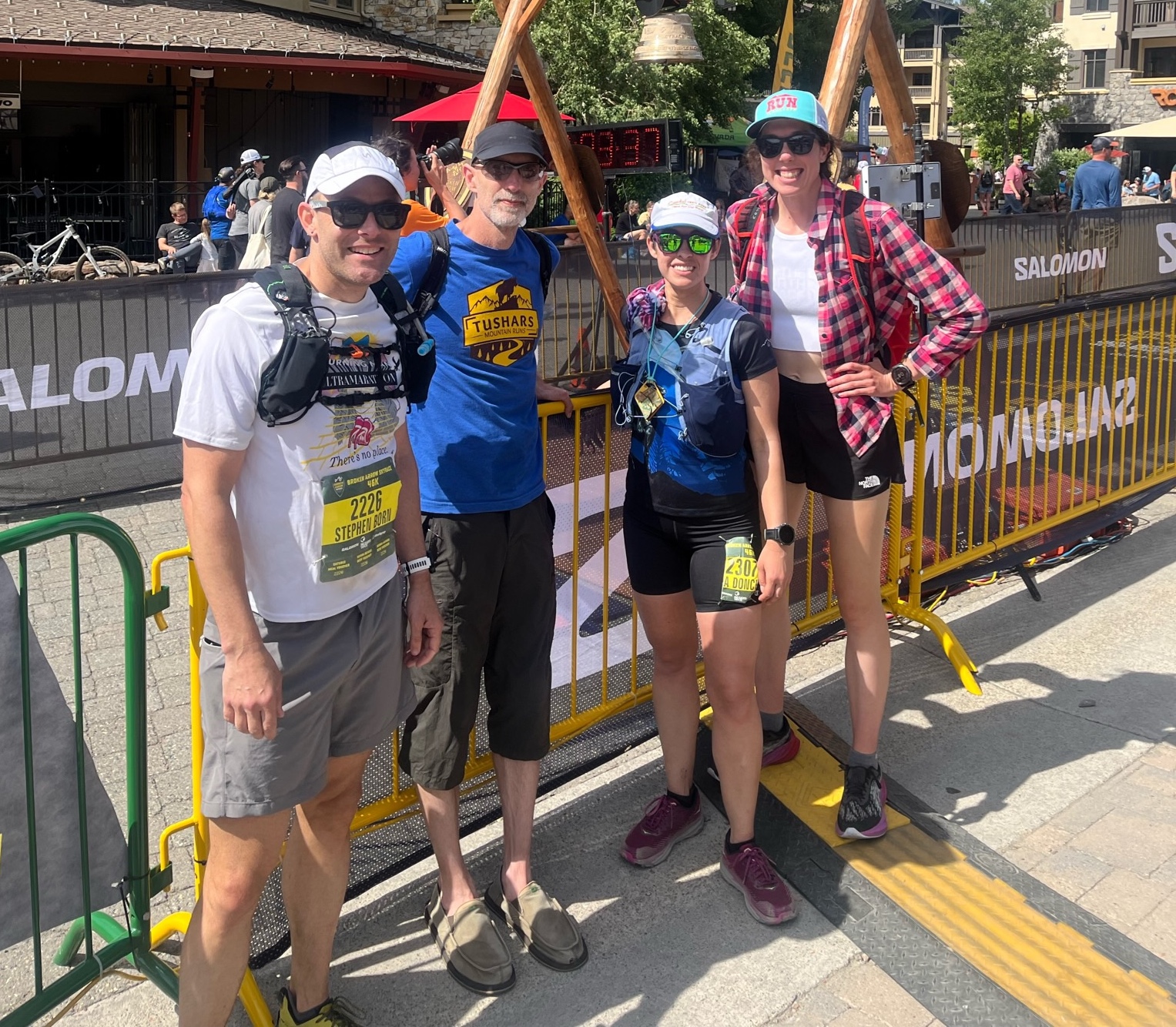
All of us after the finish of the 46k
Analysis #
| Segment | Overall | Division | Time |
|---|---|---|---|
| Snow King | 136 | 103 | 4 |
| Siberia | 175 | 130 | 8 |
| High Camp | 177 | 135 | 8 |
| Village | 184 | 139 | 9 |
| Snow King | 169 | 128 | 8 |
| High Camp | 155 | 117 | 7 |
| Finish | 167 | 127 | 9 |
The chart below tells about the pattern you would expect from the narrative about (though I hadn't actually looked at the chart before I wrote it.) Specifically:
- I was doing well on the climbs but badly on the downhills.
- I lost a lot of time screwing around at Snow King. Several of people who were ahead of me passed between Snow King and Siberia on the first loop.
With that said, things were tight: 4th was 6:25:27 (17 minutes behind me) and I was less than 10 minutes behind 7th. It's possible I went out a bit hard and faded, but my sense is I was actually stable and that I ran a solid, but conservative race. Probably the biggest loss is between High Camp and the Finish on the last downhill, where if I'd just been better on snow I might not have lost as much time or place.
Overall: 6:42:35, 167/542, 9/46 M50-59
23K (results, finish video) #
My initial plan for the 23K had just been to kind of hold on, but given that I actually felt OK after the 46K, I knew the course, and the 46K start time was fairly late (8:00) so I could get some rest my coach Emily Torrence and I decided it was worth going for it.

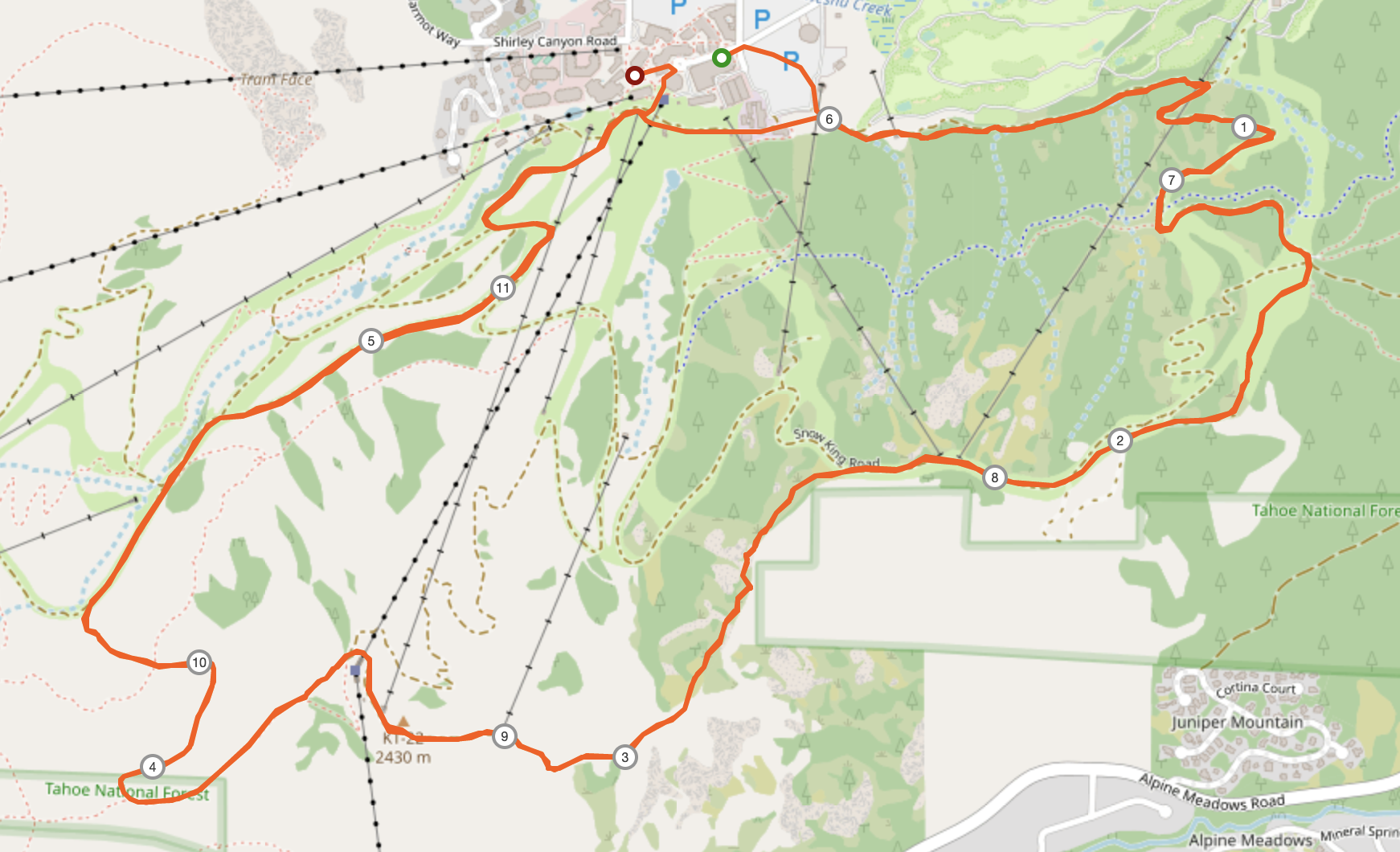
Kate and I lined up at the start only to hear the RD announce that because of very high winds at the summit they were rerouting the course from the original 23K loop to be twice the 11K loop and that they would be starting the race at 9:30 to give them time to set things up. In retrospect we should have just gone back to the VRBO to chill out, but instead we ended up just sitting in chairs out front of one of the local restaurants for the next 90 minutes.
Eventually, though, we lined up at the start. The 11K course followed some of the same sections of the WS trail but skipped a bunch of the rollers in favor of the climb to KT22 and then a fast descent on snow back down to the road, then to the finish and repeat. Given the 46K experience, I figured it was a good idea to start near the front and push the pace at the beginning so I didn't have to fight past too many people.
The first loop went quickly (only 10K afer all). After the first mile you're basically climbing the entire time up to KT22 and then it's straight back down. The downhill snow section was steep and slippery with fewer snow chutes on this course so I mostly had to just try to stay on my feet and get down as fast as possible. After the 46K I felt a lot more comfortable with the glissading this time and managed to navigate it reasonably well. Then it was onto the road and the second loop.
Split: 1:18:01
With only 11 km (officially, it was really more like 10 km, though ~2400 ft), to go in the weekend, I felt like it was safe to push the pace more on the last lap, and I ran more of the trail portions. Of course, I still had to hike the main climb, but really let myself take some chances on the final snow descent (full send!). The final mile long stretch of road is moderately steep and while I pushed the pace as fast as I felt comfortable consistent with being reasonably sure I wouldn't fall, two men and one woman passed me on this stretch. I was able to keep one of them—a man in a red shirt that I'd been back and forth with all day—in sight but the other two dropped me.
At the bottom of the road the course turns flattish and then there are a few turns and then into the shoot. As soon as I hit this section I knew that it was more about power than about the ability to run downhill and I could see that I was gaining on the man in red in front of me, and I eventually caught him right as we entered the chute. I was actually expecting a sprint finish as I went on by, but he didn't respond so I ended up comfortably beating him by five seconds.
Overall: 2:38:58, 169/671, 5/56 M50-59
Analysis #
Overall I think this was my best race of the three both in terms of results and how I felt: my place was highest both overall and in my division and I almost felt stronger going into lap 2 than lap 1, and this is confirmed by the even splits. I'm still doing a lot better on the climbs than the descents, but that gap seems to have narrowed from the 46K. You always look a bit worse in the finish videos than you feel inside, but I'm moving well and passing people at the very end is generally good.
| Segment | Overall | Division | Time |
|---|---|---|---|
| Snow King | 164 | 3 | 34:15 |
| Village | 183 | 8 | 1:18:01 |
| Snow King | 160 | 4 | 1:53:38 |
| Finish | 169 | 5 | 2:28:58 |
Overall #
Broken Arrow also keeps Triple Crown standings, computed by the sum of all your times. This tends to really overweight the 46K, where I was just OK, but even so my result isn't bad. I was 37/100 overall and 4th/17 in M50-59, with a time of 10:28:38. Third was 10:22:15, which seems plausibly in reach if things had turned out differently.
Generally, this seems like a successful weekend. I had never had three days of racing before and was worried that I would be super tired but I seem to have gotten stronger as the weekend went on and wasn't even that tired after the 23K. I attribute this to a combination of a strong training block right before—including the two weeks in Flagstaff—and really paying attention to nutrition and recovery post-race on Friday and Saturday. The snow was definitely a real obstacle and I clearly would have been quite a bit faster if I'd had more practice on snow, but I felt like I got the hang of it after a few days and while people were still passing me it wasn't anywhere near as bad. I think I also handled nutrition well both during the race and after: I never had much GI distress (thanks, Maurten!) and only felt bonky a bit midway through the 46K, which Coke fixed up. That may also have just been the "I've got to do this loop another time???" feeling.
I'm not sure if I'd do Broken Arrow again: it's a generally well-run event and I had a good time, but I think on balance I more gravitate towards the longer events, especially those where you're covering a lot of ground rather than repeating the same part of the course. On the other hand, it was a great experience and I definitely recommend giving it a shot if you've been mostly racing standard trail ultras.
P.S. I'd been having some trouble with the engagement on my poles and the LEKI guys at the expo just swapped out the gloves. Great customer service. ↩︎
The Web site actually says you might need to run down, but that didn't happen. ↩︎
I also tried on a pair of the NNormal Kjerags. I've been looking for a new pair of race shoes and I'd heard good things about the Kjerags, but they're way too wide in the forefoot for me. This was actually kind of surprising, because NNormal is a partnership between Kilian Jornet and Camper and the shoes that Salomon made for Kilian were all narrow. ↩︎
